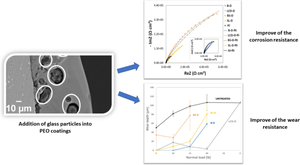Effect of Different Types of Glass Powders on the Corrosion and Wear Resistance of Peo Coatings Produced on 6061 Aluminum Alloy
Abstract
6061 Aluminium alloy was treated with plasma electrolytic oxidation (PEO) in an alkaline silicate-base electrolyte. Recycled glass particles from consumer goods waste were added to the electrolyte in order to investigate the impact of these particles on corrosion and wear resistance of the alloy. A comparison of glass particles from different sources (liquid crystal display (LCD) glass, borosilicate (BS) glass, and soda-lime (SL) glass) has been made. Also, the effect of different current modes, direct (D) and pulsed (P), on glass incorporation and the coatings morphology was studied. The microstructure and thickness of the produced coatings were studied through SEM–EDS analysis and XRD. The wear resistance was evaluated by dry sliding tests vs AISI 52100 bearing steel (block-on-ring contact geometry). The corrosion behavior was analyzed by potentiodynamic polarization (PDP) and electrochemical impedance spectroscopy (EIS), and localized electrochemical characteristics were determined by scanning electrochemical microscopy (SECM). The results evidenced that the addition of glass improved the corrosion resistance of the samples due to the sealing effect on the typical pores of the PEO layer. In detail samples filled with glass particles show from EIS tests polarization resistances up to one order of magnitude higher than the untreated sample in the case of direct current mode and up to two order of magnitude higher in the case of pulsed current mode. The effect on wear resistance is instead strictly related to the type of glass as, if compared to the base PEO layer, it is improved only by selected additives with the more promising results obtained with the LCD glass in direct current mode that produce a decrease of the wear depth of around one order of magnitude in comparison with the sample PEO treated without glass addition. Globally the more promising type of glass particles, both in term of improvement of the wear and of the corrosion properties, seem to be the LCD glass particles. This fact was related to the particular chemical composition of this type of glass and in particular with the alkali-free composition of the glass.
Graphical Abstract


 求助内容:
求助内容: 应助结果提醒方式:
应助结果提醒方式:


